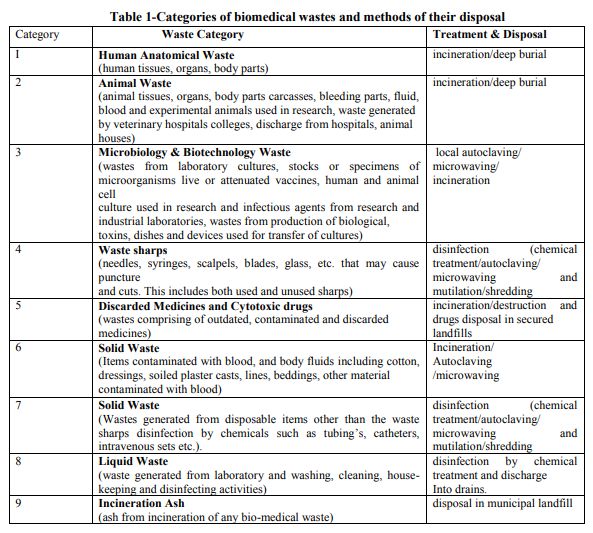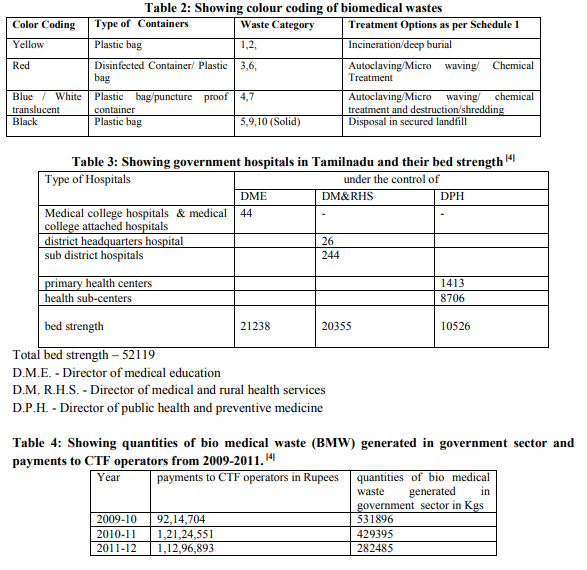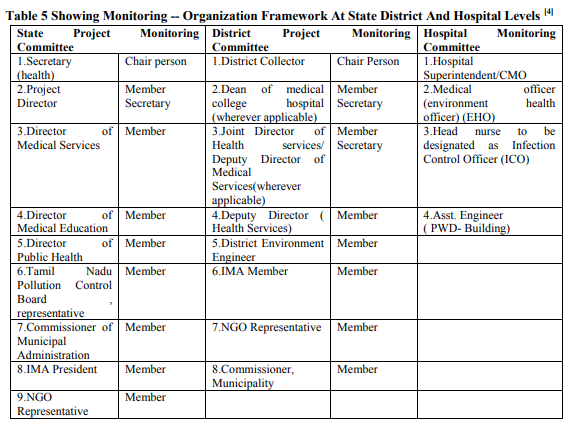IJCRR - 5(17), September, 2013
Pages: 102-111
Date of Publication: 12-Sep-2013
Print Article
Download XML Download PDF
IMPLICATION OF PROJECT ON UPGRADATION OF SAFETY IN HEALTH CARE (PUSH) AMONG GOVERNMENT SECTOR IN TAMILNADU
Author: Manimekalan Arunachalam, Vetrivel Chezian Sengodan
Category: Healthcare
Abstract:Background: During the past few years, there has been an increase in public concern about the management of health care waste on a global basis. Due to public awareness and litigations, health care Waste collection and proper disposal have become a social issue in India. Objectives: The objective of the study is to analyze the implication of Project on Up gradation of Safety in Health care (PUSH) in health care waste management among government sector in TamilNadu. Methods: The amount of health care waste generated and the expenditure incurred among government sector from primary care level to tertiary care in Tamilnadu were studied. The study period was from 2009-10 to 2011-12.It is a cross sectional study. Results: There was a reduction of biomedical waste generated from 2009-10 to 2011-12. There was a reduction of health expenditures to CTF operators from 2009-10 to 2011-12. Conclusion: It was found that there was reduction of biomedical wastes generated and the reduction of expenditure to CTF operators due to Project on Up gradation of Safety in Health care (PUSH) in health care waste management among government sector in TamilNadu and this type of project can be followed in other part of India.
Keywords: Biomedical waste, TamilNadu, hospital, PUSH Project, government.
Full Text:
INTRODUCTION
A modern hospital is a complex, multidisciplinary system which consumes thousands of items for delivery of medical care and is a part of physical environment. All these products consumed in the hospital leave some unusable leftovers i.e. hospital waste. The last century witnessed the rapid mushrooming of hospital in the public and private sector, dictated by the needs of expanding population. Lack of awareness has led to the hospitals becoming a hub of spreading diseases rather than working toward eradicating them. The advent and acceptance of “disposable” have further increased the generation of hospital waste in the current scenario. Medical waste is a special category of waste because it poses potential health and environment risks, typically including sharps, human tissues or body parts and other infectious materials. Hospital waste is a potential health hazard to the health care workers, public and flora and fauna of the area. India participated in the United Nation?s Conference on human environment held at Stockholm in June 1972, where decisions were taken to take appropriate steps for protection and improvement of human environment. Therefore, the Environment (Protection) act 1986 was formed by the Ministry of Environment and Forest, which is the most comprehensive Act on the Indian statute book relating to Environment protection. In July 1998, the Government of India Environment (protection) act 1986 (Rule 29 of 1986) issued a Notification on Biomedical waste (Management and Handling), rules 1998, indicating the rules for management and Handling for the management and handling of biomedical waste. The Government of India (notification 1998) specifies hospital waste management is part of hospital hygiene and maintenance activities. Despite the fact that current medical waste management practices vary from hospital to hospital, the problematic areas are similar for all healthcare units and at all stages of management, including segregation, collection, packaging, storage, transport, treatment and disposal. Biomedical waste means any waste, which is generated during the diagnosis, treatment or immunization of human beings or animals or in research activities pertaining thereto or in the production or testing of biologicals, and including categories as mentioned in Schedule I[1] [Table 1]. It was long thought that proper handling of health care wastes were not done in developing countries, due to lack of scientific methods of segregation. In Tamilnadu, proper segregation and disposal of wastes had taken place even before 3800 years in Adichanallur. [2] According to the Archeological survey of India, the inhabitants of Adichanallur used an ingenious method to bury their dead human bodies in an urn on a hillock, where they could not be flooded by the nearby river or the lake [Figure 1, 2]. It was the method of segregation, which was practiced in Tamilnadu, even on 5th century B.C [2] . Poor management of Health care waste exposes healthcare workers, waste handlers and the community to infections, toxic effects and injuries [3]. The management of health-care waste is an integral part of a national health-care system. A holistic approach to health-care waste management should include a clear delineation of responsibilities, occupational health and safety programs, waste minimization and segregation, the development and adoption of safe and environmentally sound technologies and capacity building. Recognizing the urgency of this problem, the Government of Tamilnadu have implemented health care waste management plan through Health System Development Project (HSDP) with World Bank assistance in 2008. A major component of the plan is professional training of all the stake holders to ensure the understanding of proper disposal of bio medical waste, safety of the health personnel and people. Under the health care waste management plan, Bio-Medical Waste (BMW) generated from the health care sector will be segregated as per the colour coding prescribed by the bio medical waste handling rules [Table 2] and to generate a massive awareness in the community about the need for the safe disposal of bio medical waste. [4]
MATERIALS AND METHODS
All the health care providing centres in the government sector of Tamilnadu from the primary to tertiary level were in the study group (Table 3, figure-3). The period of study was from the year 2009-10 to 2011-12. The total number of bed strength was 55014. The biomedical waste generated in the above centers and the expenditures incurred for biomedical waste management were studied. It is a cross sectional analysis evaluating the generation of biomedical waste per bed per day among government sector in tamilnadu
RESULTS
Biomedical waste generated in Tamilnadu for the year 2009-10 is 531896 kilograms, in 2010-11 it was 429395 Kilograms and in 2011-12 it was 282485 kilograms for the total bed strength of 55014[figure-4]. There was also a reduction of expenditure to CTF operators from 2009 to 2011 [Table 4, figure-5].
DISCUSSION
The objective of BMW management are mainly to reduce waste generation, to ensure its efficient collection, handling, as well as safe disposal in such a way that it controls infection and improves safety for employees working in the system. Seventy five to ninety percent of the waste generated by the health care providers is non toxic or general waste[1] . It comes from administrative and housekeeping functions of the health care establishments are taken care by the local bodies. The remaining 10-25% is health care waste is hazardous and creates a variety of health risks [1]. According to WHO report 85% of hospital waste is non-hazardous waste, around 10 % are infectious waste and around 5% noninfectious but hazardous waste.[5] It is estimated that annually about 0.33 million tons of hospital waste is generated in India and, the waste generation rate ranges from 0.5 to 2.0 kg per bed per day. The solid wastes from the hospitals consists of bandages, linen and other infectious waste(30-35%), plastics (7-10%), disposable syringes(0.3-0.5%), glass(3-5%) and other general wastes including food(40-45%) [6] . Effective management of biomedical waste is not only a legal necessity but also a social responsibility. [5] In 2006, Gupta S. Boojh did a study on biomedical waste management attitudes in Northern India. The study revealed that the infectious and non-infectious wastes are dumped together with in the hospital premises and disposed with municipal waste. The results of the study revealed the need for strict enforcement of legal provisions and a better environmental management system for the disposal of bio medical waste.[7] In 2006, N. Mathar Mohideen did a study to assess the knowledge, attitude and performance of nurses on Bio Medical Waste management in selected hospitals in Karnataka. The study showed that very negligible percentage of the nurses had high knowledge (1.7%) and more than seventy five percent of the nurses had below average knowledge. The study revealed the necessity for a training programme on biomedical waste management.[7] Deepali Deo et al in 2006 have concluded that the objective of Biomedical Waste Management are mainly to reduce waste generation, to ensure its efficient collection, handling as well as safe disposal in such a way that it controls infection and improves safety for employees working in the system. The study concluded that it will be apt to remember recommendations of WHO „Human element is more important than technology?. [8] A study in 2011 by Ketan V. Lakahtria conducted in Ahmedabad has observed that there is a gap between biomedical waste rules and inadequate state of waste management. Safe and effective management of waste is not only a legal necessity but also a social responsibility. [5] KAP study conducted in Northern India by Vanesh mathur et al in 2011 have insisted on compulsory continuous training for the healthcare personals in accredited training centers.[9] A study conducted by Boss U J et al in 2009 in puducherry government general hospital have concluded that in India, not much attention has been paid to the management of biomedical waste (BMW) and recommended the establishment of standards and periodic monitoring along with effective training of personnel. [10]. According to WHO (biomedical waste 2004) the human element is more important than the technology alone. Almost any system requiring treatment and disposal that is operated by well trained and well-motivated staffs provide more protection for staffs, patients and the community than an expensive or sophisticated system that is managed by staffs who do not understand the risks and the importance of their contribution (Biomedical waste2004). Although education about health care waste management is included in undergraduate medical courses, it may be essential to make it a part of continued professional education and strictly implemented with 100% compliance. According to the biomedical handling rules the state governments were made responsible for effective implementation. In Tamilnadu, Biomedical waste awareness program was started by the Government of Tamilnadu in 2008 through a “project for upgrading safety in health care”(PUSH).This programme is monitored by the Tamil nadu health system project(TNHSP) in collaboration with National rural health mission, Tamil nadu pollution control board and Tamilnadu AIDS prevention and control society. The aim of the project is to establish 11 regional training centers to train 150 health care providers as trainers in bio medical waste management. Trainers will in turn train 40,000 health care providers in the state of Tamilnadu. Doctors, medical students, nursing staff, laboratory technicians, and radiographers were involved in this program and the essentials of biomedical waste management were summarized to them by experts. This program was made compulsory for all the health care professionals due to the importance of proper segregation of biomedical wastes at the site of their production.[4, 11, 12]. The biomedical wastes are segregated as per the colour coding issued by the government of India and transported to the storage room available in the health care centers.[8] The effective segregation of biomedical waste at the site of their production will help in the prevention of hazards of biomedical waste. The nursing supervisors are fixed with the responsibility to supervise biomedical waste registers regarding segregation maintained by the staff nurses available in all the work stations namely wards, outpatient services, casualty, labour room and operation theatres on day to day basis. The colour coding charts are provided in the regional language and pasted near the colour coded baskets in all work stations for immediate reference. With private public partnership the common treatment facility (CTF) is taken care by the private operators. Consent for operating CTF facility was given by the government of Tamilnadu to eight operators located at Chengalpattu, Sriperumpudur, Vellore, Salem, Tanjavur, Arupukottai, Tirunelveli and Coimbatore covering thirty districts of Tamilnadu. It is the responsibility of these agencies to take away the biomedical wastes from the storage room of health care centers till safe disposal in the common treatment facility.[11, 12] To monitor effective implementation of biomedical waste management, State level, district level and hospital level monitoring committees have been formulated (Table 5). In the state and district level committees NGO, Indian medical association are included apart from government officials from Tamilnadu pollution control board and municipal department. From our study it is evident that the expenditure on CTF operators have also been declined every year from 2009 to 2011. [Table 4].This is possible only through segregation of health care waste at the source of generation, implemented by the Project on Up gradation of Safety in Health care (PUSH) plan of government of Tamilnadu for health care waste management among government sector in Tamilnadu.
CONCLUSION
Wherever hospital waste is generated, a safe and reliable method for handling of biomedical waste is essential. Segregation of Biomedical Waste is considered the most important steps in Biomedical Waste Management. It is the responsibility of the occupier to segregate biomedical wastes at source. From our study it?s evident that right investment of resources and commitment has resulted in a substantive reduction in health expenditures to CTF operators. [Table 4]. Continuous training, monitoring, periodic evaluation are the key points for the successful implementation of Project on Up gradation of Safety in Health care (PUSH) plan of government of TamilNadu executed by TamilNadu Health System Development Project. Effective management of biomedical waste is not only a legal necessity but also a social responsibility which is achieved by proper segregation of health care waste at the source of generation in the health care centres among government sector in TamilNadu. Project on Up gradation of Safety in Health care (PUSH) plan of government of TamilNadu can be adopted in other parts of India for better implementation of health care waste.
ACKNOWLEDGEMENT
Authors acknowledge the great help received from the scholars whose articles cited and included in references of this manuscript. The authors are also grateful to authors / editors / publishers of all those articles, journals and books from where the literature for this article has been reviewed and discussed. Authors are grateful to IJCRR editorial board members and IJCRR team of reviewers who have helped to bring quality to this manuscript.
References:
1. Park K. Hospital Waste Management. Park?s Textbook of Preventive and Social Medicine. 20th Edn, 2009: 694-699.
2. The Hindu, Urn burial site discovered in Tamil Nadu district, Available from:http://www.hindu.com/2004/03/14/stori es/2004031400151100.htm , [Accessed 10th January 2013]
3. Rutala WA (1987). Infectious waste - A growing problem for infection control. Asepsis, 9: 2-6
4. Tamilnadu state level committee for hospital waste management , Available from: (http://www.tn.gov.in/gorders/eandf/environ7 2-e.htm), [Accessed 10th January 2013]
5. Ketan V. Lakahtria: Biomedical Waste Management Systems for Urban Hospital: institute of technology, nirma university, Ahmedabad – 382 481, 08-10 December, 2011
6. Patil AD, Shekdar AV. Health-care waste management in India. J Environ Manage. 2001; 63:211–20. [PubMed]
7. Mrs.Seshamba kandanala: a study to assess the knowledge and attitudes on biomedical waste management among staff nurses at s.n.r. district hospital, Kolar: 2010
8. Deepali Deo, Tak S B, Munde S. A Study of Knowledge Regarding Biomedical Waste Management among Employees of a Teaching Hospital in Rural Area. Journal of ISHWM. 2006 April; 5(1): 12-5.
9. Vanesh Mathur, S Dwivedi, MA Hassan, and RP Misra Knowledge, Attitude, and Practices about Biomedical Waste Management among Healthcare Personnel: A Cross-sectional Study: Indian J Community Med. 2011 AprJun; 36(2): 143–145.
10. Boss UJ, Moli GP, Roy G, Prasad KV, Biomedical waste generation in Puducherry Government General Hospital and its management implications, J environmental health 2009 May;71(9):54-8.
11. Health & family welfare department, government of tamilnadu, Available from:(http://www.tnhealth.org/mehospitals.ht m), [Accessed 10th January 2013]
12. Ministry of Environment and forest notification on the Bio-Medical Waste (Management and Handling) Rules. 1998,Newdelhi.



|






 This work is licensed under a Creative Commons Attribution-NonCommercial 4.0 International License
This work is licensed under a Creative Commons Attribution-NonCommercial 4.0 International License